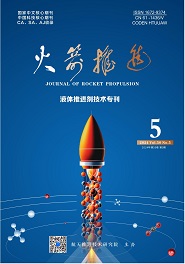航天推进技术研究院主办
CHEN Yangchun,LI Shigong,HU Chengyun.Thermal design and flight verification of orbit control unit in core cabin of space station[J].Journal of Rocket Propulsion,2022,48(04):59-65.
空间站核心舱轨控机组热设计及飞行验证
- Title:
- Thermal design and flight verification of orbit control unit in core cabin of space station
- 文章编号:
- 1672-9374(2022)04-0059-07
- 关键词:
- 空间站 核心舱 轨控机组 热设计 验证
- 分类号:
- V434
- 文献标志码:
- A
- 摘要:
- 为验证核心舱轨控机组热控设计能满足空间站任务期间任何工况对机组温度的要求,运用I-DEAS/TMG软件,通过仿真分析确定了轨控机组低温工况下所需的加热功率,预示了高温工况下的最高温度。在轨飞行情况表明:轨控机组飞行温度验证了理论计算的正确性,二者之间的偏差约3.7 喷管受太阳照射面积越大,头部及电磁阀温度越高,在太阳角58°时,喷管受照面积最大 低温工况下,有推进剂流道的机组头部和电磁阀温度高于6.8 ℃,满足高于0 ℃的指标要求 不同于以往热控包覆状态的轨控机组,被动包覆设计保证了电磁阀在极端高温工况下,温度低于40 ℃,离高温上限有较大裕度,为电磁阀在空间站15 a任务期间的可靠工作提供保障。
- Abstract:
- In order to verify whether the thermal control design of the orbit control unit in the core cabin can meet the requirements of the temperature under any working condition during the mission of the space station, I-DEAS/TMG software was used to determine the heating power required by the orbit control unit under extreme low temperature conditions, and the maximum temperature under extreme high temperature conditions was predicted.The on-orbit flight shows that the flight temperature of the orbit control unit verifies the correctness of the theoretical calculation, and the deviation between them is about 3.7.The larger the area of nozzles exposed to the sun, the higher the temperature of the heads and solenoid valves.When the solar angle is equal to 58°, the illuminated area of the nozzle is the largest.Under low temperature conditions, the temperature of unit head with propellant flow and solenoid valve is higher than 6.8 ℃,which meets the index requirement higher than 0 ℃.Inertial flight attitude belongs to high temperature condition for the pitching unit, which is different from the thermal control coating state of the previous unit, ensures that the temperature of the solenoid valves is lower than 40 ℃ under extreme high temperature conditions, which provides guarantee for the reliable operation of the solenoid valves during the 15 year mission of the space station.
参考文献/References:
[1] GILMORE D G.Spacecraft thermal control handbook[M].2nd ed.El Segundo,California:Aerospace Press,2002.
[2] 范含林.载人航天器热管理技术发展综述[J].航天器工程,2007,16(1):28-32.
[3] 范含林,黄家荣.载人航天器热控制技术问题探讨[J].载人航天,2010,16(2):40-44.
[4] 闵桂荣.卫星热控制技术[M].北京:宇航出版社,1991.
[5] 侯增祺,胡金刚.航天器热控制技术:原理及其应用[M].北京:中国科学技术出版社,2007.
[6] 陈阳春.25 N双组元发动机热控研究[J].火箭推进,2015,41(2):38-42.
CHEN Y C. Study on thermal control of 25 N bipropellant engine[J]. Journal of Rocket Propulsion,2015,41(2):38-42.
[7] 胡海峰,鲍福廷,蔡强,等.液体姿控火箭发动机地面试验热结构分析[J].航空动力学报,2011,26(2):442-447.
[8] 谭维炽,胡金刚.航天器系统工程[M].北京:中国科学技术出版社,2009.
[9] 肖泽娟,程惠尔,李鹏.姿控发动机真空深冷环境中传热研究[J].热科学与技术,2005,4(2):101-106.
[10] 徐繁荣,汪琼华,王晓红.长二丁运载火箭二级姿控发动机热控设计及其试验验证[J].上海航天,2007,24(5):41-46.
[11] 孙冰,蔡国飙,陈全,等.单组元发动机热回浸现象的理论分析[J].推进技术,1997,18(3):40-44.
[12] 韩崇巍,赵啟伟,张旸,等.第二代490 N发动机热控设计[J].航天器环境工程,2013,30(4):388-391.
[13] 王爱华,陈阳春,丁卫华.空间实验室490 N发动机热控设计[J].火箭推进,2018,44(3):12-15.
WANG A H,CHEN Y C,DING W H.Thermal control design of 490 N engine in space laboratory[J].Journal of Rocket Propulsion,2018,44(3):12-15.
[14] 张忠利.姿控发动机热防护研究[J].火箭推进,2008,34(3):17-22.
ZHANG Z L.Investigation on thermal protection for attitude correction liquid rocket engine[J].Journal of Rocket Propulsion,2008,34(3):17-22.
[15] 方磊,刘伟.姿控用再生冷却推力室传热特性研究[J].火箭推进,2008,34(6):6-13.
FANG L,LIU W.Research on heat transfer characteristic of regeneratively cooled attitude control engine thrust chamber[J].Journal of Rocket Propulsion,2008,34(6):6-13.
[16] 刘海娃,胡承云,叶胜.HAN基无毒单组元发动机热控研究[J].火箭推进,2020,46(4):38-45.
LIU H W,HU C Y,YE S.Study on thermal control of HAN-based green monopropellant thruster[J].Journal of Rocket Propulsion,2020,46(4):38-45.
[17] 刘昌国,关亮,施伟,等.单组元300 N发动机低温试验研究[J].推进技术,2021,42(7):1662-1670.
[18] 卢威,黄家荣,范宇峰,等.载人航天器密封舱流动和传热数值模型及其地面验证[J].宇航学报,2011,32(5):959-965.
[19] 叶宏,焦冬生,徐斌,等.I-DEAS热分析实用教程[M].合肥:中国科学技术大学出版社,2003.
[20] SCHNEIDER G E,RAW M J.Control volume finite-element method for heat transfer and fluid flow using colocated variables:1.computational procedure[J].Numerical Heat Transfer,1987,11(4):363-390.
[21] KARIMIAN S,SCHNEIDER G.Pressure-based control-volume finite-element method for flow at all speeds[C]//6th Joint Thermophysics and Heat Transfer Conference.Reston,Virginia:AIAA,1994.
[22] 钟杨帆,朱敏波,魏锋.I-DEAS在航天器热分析中的应用[J].计算机工程与设计,2006,27(12):2306-2308.
备注/Memo
收稿日期:2022-02-09 修回日期:2022-03-25
基金项目:国家自然科学基金(U21B2088)
作者简介:陈阳春(1982—),女,硕士,高级工程师,研究领域为航天器推进系统热控。
